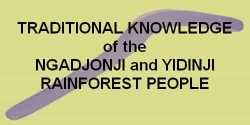Repatriation of the Stolen Remains of King Ng:tja
**Caution this page may contain images of persons now deceased**Son of Ng:tja - Survivor of the Butchers
Creek Massacre
Survivor "Douglas Grant"
given to Robert Grant, a Scottish zoologist employed by Sydney’s
Australian Museum, and his wife, Elizabeth
‘White people know nothing
about our culture and its not their fault’
Theft of Ng:tja
"Douglas Grant" prisoner of War in
Berlin
Could Douglas Grant
have seen his father's mummified remains in Berlin without even
knowing it?
World War I Aboriginal and Torres Strait
Islander volunteers
The Story of "Douglas Grant"
Repatriation of the Stolen Remains of King
Ng:tja
Australian War
Memorial resistance to Indigenous commemoration

What about Ng:tja? - "Narcha" – Barry Clarke – was given to wear a plate inscribed “Naicha, King Boonjie”
His mummified body stolen in 1904-05 by German-born Darwinian anthropologist, Herman Klaatsch
The following article is by Paul Daley of the Guardian Friday 16 October 2015 09.52 AEDT “Courtesy of Guardian News & Media Ltd”
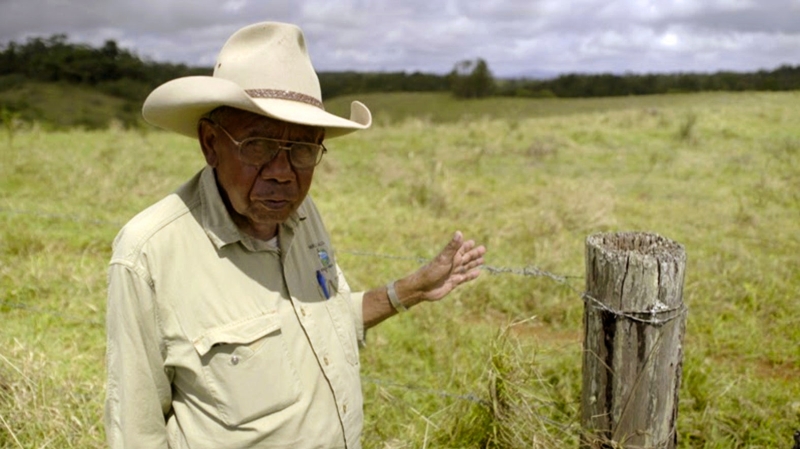
Ernie Raymont, a Mumu-Ngadjon elder, near the site of an 1887 massacre at Butchers creek in the Atherton tablelands of far north Queensland.
This is close to the place from which the Ngadjon boy who would become "Douglas Grant" was stolen.Photograph: Tarpaulin Productions
"Son" of Ng:tja - Survivor of the Butchers Creek
Massacre 1887
Butchers Creek isn’t flowing today despite the rain that whips across the
cane fields in drenching horizontal sheets. So imbued with evil happening
is Butchers Creek that my imagination had rendered it a treacherous
torrent inside a deep, black ravine. But it’s scarcely a creek at all –
more a shallow furrow, carpeted with lush grass, that snakes its way
through a clearing and into the rainforest.I’ve been to many Aboriginal massacre sites, although always with an Indigenous guide to assure the “old people” – the spirits – I’d come peacefully. This time I’m alone. It immediately feels like I’m anything but. Boonjie, a Russell river goldfields town in the Atherton tablelands of far north Queensland, long ago ceased to be. But in 1887 this nearby gentle creek, its banks home for countless thousands of years to a tribe of Ngadjon rainforest people, was so named after becoming the stage for mass murder. White miners and “black police” (Indigenous recruits from elsewhere who had little compunction about killing other Aboriginal people at the behest of the miners) murdered the Ngadjon in reprisal for the killing of Frank Paaske, a Swedish gold panner. Then they named it Butchers Creek. There was at least one other massacre, two years later, in roughly the same place. A tablelands pioneer, Fred Brown, boasted of the massacre, detailing a “dispersal” that involved staking out the Aboriginal camp overnight, shooting a man with his “old Schneider rifle” (“makes a bigger hole leaving the body than on entering it”) and “protecting” a Ngadjon boy. The child and at least one Ngadjon man – an elder known to his people as Narcha but christened by the miners “Barry Clarke” because he’d worked for a successful miner and pioneer called George Clarke – were spared. The boy’s mother was killed. Narcha had five wives and many children. He might have been the boy’s uncle, grandfather, even his father. They definitely had a close kin relationship and if they had met up after the massacre, as one of as few as three survivors, the relationship would surely have been one of "father - son". Estimates of the boy's age vary depending on accounts as being between 6 months and 6 years old.
Survivor "Douglas Grant" given to Robert Grant, a Scottish zoologist employed by Sydney’s Australian Museum, and his wife, Elizabeth
But the child was given to Robert Grant, a Scottish zoologist employed by Sydney’s Australian Museum, and his wife, Elizabeth. She’d wanted “to get a little black boy”. They had been working nearby on the tablelands collecting specimens.Another sinister, little examined element of frontier history that arises frequently in accounts of massacres – that of the abduction of black children for induction into white families – is touched on here. In most popular accounts, the child was “rescued” or “saved” rather than stolen after his mother’s murder. The boy became "Douglas Grant", the adopted son of Robert and Elizabeth, and brother to Henry. I’ve written extensively about Grant, who became something of a celebrity black Australian soldier in the first world war, the appropriation of his story and the limpet-like myths that have been attached to it by historians, journalists and dramaturges over the past century or so. Tom Murray, a Sydney film-maker whose work has won a string of Australian and international awards, has spent the past five years researching – in Australia and Germany – the lives of Grant and Narcha. He has pieced together an extraordinary story of their violent parting in the rainforests of the tablelands, and of their individual journeys to Sydney and Berlin. The story is a confronting and darkly serendipitous microcosm of the extreme violence that unfolded across the Australian colonial frontier after invasion in 1788 and dispossession. “The story of Douglas Grant takes us from the far north Queensland rainforests and the colonial frontier to the centre of Sydney society,” Murray says. “It takes us into the battlefields of the western front and to the centre of a certain kind of German thinking that ultimately led to the rise of the Nazis. “Douglas Grant was caught in the middle of so many moments that have been pivotal to Australian and to world history. I felt compelled to find out more about him.”
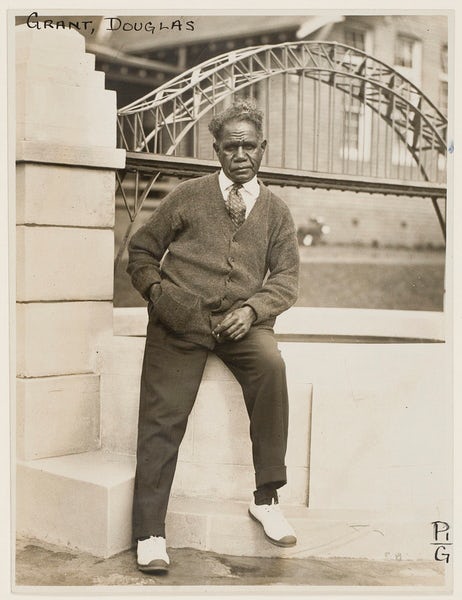
Douglas Grant, whose story moves from the far north Queensland rainforests to the battlefields of the western front. Photograph: Sam Hood/State Library of New South Wales
Douglas Grant, draughtsman and soldier, with his ornamental pond and Harbour Bridge, Callan Park, between 1932 and 1940. Photograph: Sam Hood/State Library of New South Wales
Murray’s exhaustive research has sheds light on a largely unspoken element of continental history. Advertisement Ernie Raymont is a softly spoken and welcoming Mumu-Ngadjon elder who for years guided tour groups through the rainforest around Malanda, the town that grew out of Boonjie, to explain the region’s Aboriginal heritage. “The massacre that happened here at Boonjie – that was just one of many around here,” Raymont says. “This did happen and you have to accept the fact. Non-Indigenous and Indigenous people have to accept the facts. They need to be aware of the facts. Our people were killed. “It’s going to take another four generations for non-Indigenous people to recognise that it did happen, all these massacres did happen. And it wasn’t just here. It was all over Queensland, all over Australia.” As yet the story of Grant and Narcha has no ending. Grant is buried at La Perouse, Sydney’s oldest Indigenous settlement, while the body of Narcha, who died in about 1903, is still in Germany. Their spirits belong back here, with all the others, along the banks of this damp, windswept furrow – Butchers Creek.
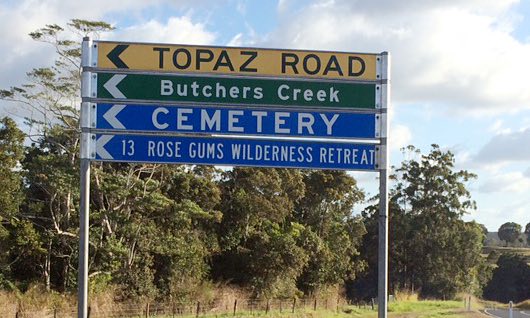
A sign to Butchers Creek, where the Ngadjon were mudered. Photograph: Paul Daley for the Guardian
‘White people know nothing about our culture and its not their fault’
Sentiment echoed by today’s residents of the tablelands, the pioneers and miners would call this land “God’s own country”. While the country belonged to a number of rainforest peoples including the Ngadjon and Yidindji, it’s easy to understand what they meant. The earth is profoundly fecund. Where it is tilled in the fields lining the roads it resembles, to my mind, the rich ochre and chocolate hue of black forest cake. They say you can grow anything here, where the white pioneering men and women cut down the mammoth trees, cleared the stumps with blood and sweat and fire and black labour and bullock drays, and then planted themselves immovably in place of the felled forest giants. The mining came first, attracting European and later Chinese chancers. Now it’s cane and other crops, and some of the best grazing pasture in the world. God’s own country.On a wall in the old mining town of Herberton is a mural depicting how the native police were “ordered to disperse” the tribes. It refers to a massacre at another stream, Scrubby Creek, in the 1880s, and the poisoned flour left out for the Indigenous people, and the dispossession and poverty that inevitably stemmed from the massacres in these parts. Myths about the rainforest people persist. They were small enough (owing to a shortage of animal protein) to be considered pygmoid. Some historians and anthropologists argued that the pygmies were the first inhabitants and were driven to small isolated refuges by waves of more aggressive Aboriginal people – a contrivance enabling white dispossessors to argue Europeans were merely part of a continuum when they took the land and overran the “old people’s tracks” through the forests and mountains that the ancestors had been walking since the Dreaming.
Another myth is that they ate human flesh and, most critically perhaps, practised their cannibalism on the Chinese and Europeans. Ernie Raymont, meanwhile, talks of an inversion of the settlement story whereby some non-Indigenous children think white people lived on the tablelands before the Aboriginal people. “White people know nothing about our culture and its not their fault – it’s the government of the day that’s to blame if people don’t know about this history and culture,” he says. “They should see it more in films and exhibitions and books and schools.” The Herberton mining museum references the local Indigenous people: “Aboriginal people have been involved in mining from the beginning, first as guides and assistants, later as miners in their own right.” Down at Historic Village Herberton – a picturesque recreation of original settlement – some 60 buildings have been restored or recreated. From the blacksmith and the baker to the bottle-o and the sawmiller, the pharmacist and haberdasher, this is a compelling experiential Australian museum that tells the white pioneering and mining story of the Atherton district. Half of one of the buildings, the Maytown Farmer’s Home, is marked “Police, Aboriginal” on the map reference. Inside are some Indigenous weapons and stone tools, and black and white pictures of local tribes around the early time of dispossession.
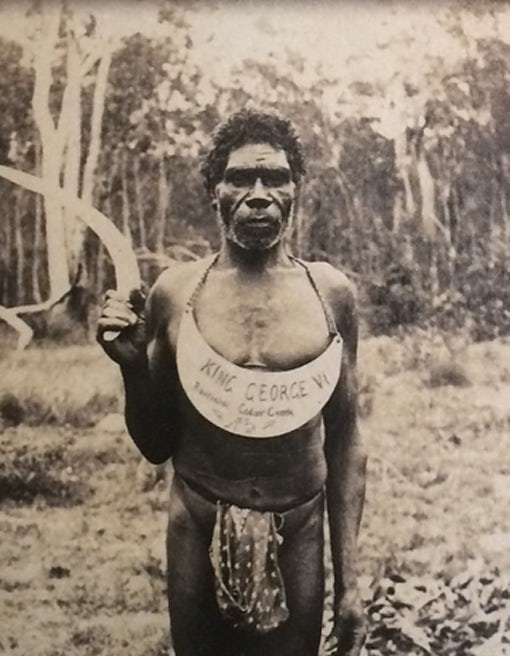
A photo of an Indigenous man with a ‘king plate’ around his neck, displayed at Historic Village Herberton
Plate inscription possibly "yamani" followed by what appears to be "Cedar Creek"
One photograph features an Aboriginal man with a metal plate, inscribed “King George VI”, around his neck. White community leaders like George Clarke bestowed “king plates” on Aboriginal men, supposedly in appreciation of their services – perhaps labouring or helping native police. Along with the substitution of tribal names with those of their English or European masters (most worked for food, tobacco, flour or other supplies, but not wages) the bestowal of king plates was but another element of the black man’s subjugation.
Narcha – Barry Clarke – was given to wear a plate inscribed “Naicha, King Boonjie”. He died in 1903. His remains were ceremonially mummified and kept by his people with the plate still around his neck.
Theft of Ng:tja
So "Ng:tja / Nacha / Naicha" died in 1903 and was ceremonially mummified by his people. In 1904-05 a German-born Darwinian anthropologist, Herman Klaatsch, travelled the Atherton tablelands to “attack the problem of the origin of Australian blacks, and of their import in relation to the whole development of mankind”. He stole Narcha (whose mummified body was bound in a crouching position) and several other mummified adults and children. He took Narcha to the Australian Museum in Sydney where Douglas Grant’s adoptive father worked, and on to Berlin where he was placed on display in a glass case in a museum. Tentative moves, supported by the federal government (**webmaster note: successful in March 2017**), are under way to repatriate Narcha. “Old Great Grandfather, his body belonged to the state – so who gave permission that he could leave?,” asks Raymont. “Indigenous people were property of the state government back then. And I don’t think that the mister professor had permission to take him. “There were a whole lot of things happening, it wasn’t only the massacres, it was the degrading of the people, the fact that people were the property of the state government and all that."Douglas Grant" prisoner of War in Berlin
Defined by his colour in Berlin So much has been written by so many about Grant, who joined the 1st Australian Imperial Force in 1916, that his truth is elusive. Thanks to Murray’s research we may soon know much more of the actual story. Here is a little of what has been established.Grant was an above-average student at Annandale primary school and, with age, developed an aptitude for visual art and an appreciation of classical English literature (especially Shakespeare) and the Australian bush bards. Grant’s adoptive mother spoke of him lovingly and his father fondly. While Elizabeth indicated that Douglas, the boy, was conscious of his colour (he’d wash his hands in an attempt to make them whiter), there is little on the public record to suggest that he was actively discriminated against. Or at least until he went to enlist in the 1st Australian Imperial Force in mid 1916. He was about to deploy when an official stopped him, probably because he was black.
The impediment overcome, Grant fought on the western front and was wounded and captured by the Germans at Bullecourt in late 1917. He was transferred to a Berlin prison camp where he served out the war. Here, colour defined him – perhaps for the first time in his adult life. He was segregated, along with other dark-skinned prisoners from the British empire – Africans, Indians, Gurkhas, the swarthier Canadians. In Berlin Grant was a curiosity. Doctors and anthropologists measured and photographed his skull; the voodoo science of phrenology, which assumed a person’s character and intelligence could be deciphered from cranial characteristics, still retained some currency in parts of Europe. The noted German sculptor Rudolph Marcuse – who spent the war specialising in “ethnographic sculpture” owing to his access to black prisoners – modelled a bust of him.
In his later, difficult, alcohol- and depression-plagued postwar years Grant would become an Indigenous activist, railing against the massacres that were still staining 20th century Australia, as well as a confidant to the elderly Henry Lawson who purveyed considerable white pioneer mythology in his writing. Grant struggled with unemployment and homelessness. In his later years he lived largely at Callan Park mental hospital before dying in La Perouse in 1951.
In Berlin Grant had been conspicuous for his shiny black skin and his distinctive features (broader than those of the other black prisoners). He was given freedom to wander the city on the assumption so many eyes would be upon him that escape would be impossible. There would have been much in Berlin’s public buildings to compel Grant, an aesthete who loved art galleries, music halls and museums. And, so, two unanswered questions must define those wanderings. Did he pass or visit the Museum of Ethnology in the Prinz Albrecht-Strasse? Did he see in a glass sarcophagus the ceremonially preserved remains of another Ngadjon man – a close kin – from whom he was separated amid such violence in 1887? At Butchers Creek.
Could Douglas Grant have seen his father's mummified remains in Berlin without even knowing it?
” Murray’s research in Australia and Berlin led to his conclusion that the 20-year-old Grant would probably have met the anthropologist Klaatsch in Sydney.“It seemed most likely that Douglas Grant was a man of the Ngadjon nation and, trawling through numerous archives in Germany, I learnt of the story of Professor Hermann Klaatsch who had stolen the body of a revered Ngadjon elder – ‘King’ Narcha. It is a pretty sure bet Douglas Grant met Klaatsch at the Australian Museum in Sydney in 1905,” he says. “It took four years of joining the dots before I could place Douglas Grant and Narcha together in Berlin and in Boonjie country, and appreciate the circumstances of their connection. “Klaatsch had sent the stolen body of Narcha to a Berlin museum that was close to the prisoner-of-war camp where Douglas Grant was held in 1918. This seemed an incredible coincidence! Grant, according to various accounts, had been allowed to wander relatively freely in Berlin. Had he ever walked past or entered the museum that held his close kin, Narcha, in a glass case? What is the chance of two family members of the same rainforest clan from a remote jungle in far north Queensland both ending up in Berlin in 1918?” ‘There’s times that you have to prove yourself’
The Tablelands regional council mayor, Rosa Lee Long, has, thanks to Murray’s research, become familiar with the Butchers Creek massacres, Narcha and Grant. She thinks her community will ultimately be fascinated – rather than repelled – by this most culturally confronting story. Advertisement She grew up near, and later owned a farm close to, the massacre site. “I’d never heard of it before, to tell the truth … and I don’t think a lot of people are aware of it either … I just struggle to find it that there were that many people here as pioneers in that area to cause such a big massacre,” she says. “But it must have happened because hence you’ve got the name Butchers Creek.” She says the regional council will financially support a repatriation ceremony when Narcha’s descendants are ready to bring him home. Lee Long, whose late husband was the grandson of a Chinese migrant, says that from time to time, in her experience, there have been racial tensions in the tablelands. But she says black and white relations have been largely harmonious of late. “I still think there is some element of racism out there – there is no doubt about that, whether it be to the Indigenous people of Australia or it be Asians or what. And I think that if you belong to any of those blocs of people … you know I’ve said to my [Eurasian] daughters you might find there’s times that you have to prove yourself a bit better that anyone else to get a job or whatever … And let me say there can be a bit of racism from the Aboriginal people themselves at times.” I ask: “Do you mean anti-Chinese racism or anti-Asian racism? Lee Long: “Yeah of course. And anti-white. Anti white – yeah. Some of them these days think that we owe them.” She retells the story, as told by her father-in-law, of his father, “Grandfather Lee Long”, who was among about 20 Chinese miners who walked from Darwin to the Palmer river goldfields, about 200km north of Atherton. “There was only about four who arrived alive and the rest of them were speared and eaten by the Indigenous people. By the blacks. And we’ve all heard those stories and that was a story handed down by the Chinese … and I asked the question once of my father-in-law, ‘Why do they call you Salty?’ “All of his Australian friends around here nicknamed [him] Salty, and he told me this story about the Chinese walking … and the story was that the Indigenous people preferred the Chinese because their meat was saltier … “And when you read stories of the mining of the Palmer goldfields there were a lot of Chinese came over to mine and there were a lot of Aboriginal people who actually attacked them, often, especially when they were walking to and from Cooktown.”
World War I Aboriginal and Torres Strait Islander volunteers
By conservative estimate 400 to 1,000 Indigenous men joined the 1st Australian Imperial Force between 1914 and 1918. They did so contrary to rules stipulating that volunteers must prove that they were of “substantially European descent”. Immediately after war’s declaration in late 1914 this was especially problematic for would-be Aboriginal and Torres Strait Islander volunteers.But amid mounting Australian casualties (especially after the AIF slaughter at Gallipoli and the European western front) the recruiters became increasingly colour blind. Some black men tried to sign up numerous times before they succeeded. Others told white lies, insisting that one or both parents were of European stock and their swarthiness was inherited from a single grandparent. In late 1917 the regulations were amended to state: “Half-castes may be enlisted … provided that the examining medical officers are satisfied that one of the parents is of European origin.” The white lies continued as more and more black men joined. The sepia unit photographs of the infantry, light horse and other corps illustrate the story: every now and then the ranks are punctuated by a black face.
Aboriginality was as impossible to hide as it was deemed irrelevant once a man had volunteered and fought – a profound irony, given that Indigenous people were not properly counted as citizens until 1967 and were regarded until then, officially at least, among the continental flora and fauna. In her book Ngarrindjeri Anzacs, Doreen Kartinyeri considered 21 men (including Trooper Alfred Cameron junior, the subject of Hego’s Redfern mural) from the Raukkan mission and the lower Murray who enlisted and fought. The 21, she said, comprised about 20% of the district’s Indigenous men of enlistment age. This compared with an enlistment rate of about 9% for the general, eligible male community. Five of the 21 died. Kartinyeri wrote: I find it difficult to understand how so many Aboriginal men were allowed to enlist in the army, as they were not allowed to vote in federal and state elections and they were not counted as human beings. Why did the government want them to enlist? Was it because they did not care who went to fight the war for them? I feel strongly that the protector of Aborigines should have stepped in and stopped them from enlisting. When I look back over the history of my people, I see the [Aboriginal] protector interfering in all aspects of Aboriginal people’s lives, most of the time for no good reason. And yet here they had a good reason but did nothing to stop the men enlisting. My mother and her family always blamed the protector for the deaths.” To my mind Kartinyeri comes close to the central paradox about Indigenous servicemen – particularly those of the first world war whose antecedents just two or three generations earlier would have experienced first white contact and all of its associated violence, dispossession and injustice.
On the face of it the black diggers of the first world war were fighting for an empire that had invaded their country, killed their relatives and stolen their land. They fought for all sorts of reasons: because their mates had signed up; because of the offer of steady pay and to travel. Many talked then – as this year’s Naidoc Week highlighted – about the unique Indigenous significance of fighting for “country” rather than empire. For some who fought, this paradox was profound. Perhaps never more so than for Private Douglas Grant. The pervasive Australian story about “black diggers”, as told by the War Memorial and largely confirmed in the oral and written histories of the black servicemen themselves, is that “once in the AIF, they were treated as equals. They were paid the same as other soldiers and generally accepted without prejudice.”
Demobilisation after the armistice in 1918, however, often brought a cruel return to prewar life for Indigenous soldiers. Some returned to Australia to find that family land had been carved up to provide soldier settlement blocks for white veterans. Others, who’d sent money home from the front, discovered that venal protectors had stolen it and that their families, unable to support themselves in their absence, had been broken up and the children taken to orphanages. Most were not paid their postwar entitlements and were denied the repatriation health services – if injured – that were available to other veterans. While Grant is today held up as something of an exemplar of the Indigenous experience in the first world war, in many ways what he went through was atypical; a series of remarkable events from early childhood until his postwar return to Australia meant that skin colour really only became a defining facet of his life during the war. Grant is fascinating – and anything but representative.
The Story of "Douglas Grant"
from the Guardian article by Paul Daley Wednesday 25 March 2015 14:04 AEDT “Courtesy of Guardian News & Media Ltd”Douglas Grant was born in the bush around Queensland’s Bellenden Ker range in about 1885. His people, the Ngadjonji, had been in constant conflict with pastoralists, miners, police and black trackers as the colonial frontier expanded. According to both the Australian Dictionary of Biography and the war memorial, Grant’s natural parents were killed in a tribal fight when he was about two. But other credible accounts suggest they met more sinister deaths. In The Embarrassing Australian, a biography of Reg Saunders, an Indigenous Australian who fought in the second world war, Harry Gordon recounts that “several white traders had been killed by blacks” in Ngadjonji country: black troopers employed by the police had arrived, and they were busy extracting as much retribution as they could from the families of the natives who had been concerned in the fight. One of the troopers had actually picked up a two-year-old boy by the ankles, and was about to belt his head into the trunk of a tree. But according to Gordon, a Scottish-born zoologist, Robert Grant, and his wife, Elizabeth, who were on an expedition to collect birds for the Australian Museum in Sydney, “dragged the youngster from his hands”. For a few days Grant and his wife cared for the boy, until he was carried out of their camp one night by his sister – a girl aged about seven. Next day Grant tracked them down, both cowering terrified in a hollow log. The girl (**webmaster note: likely the grandmother of Emma Johnston. Emma returned to the Bulaba Bora Ground near Butchers Creek in 1999. Alternatively, her description of a massacre in 1880 may be a second recorded instance of murder near the same site**) ran away almost as soon as she had been given a meal and the Grants promptly decided to take the boy back to Sydney with them.
In the Townsville Bulletin many years later, Fred G Brown, a former miner, recounted in vivid detail his participation in a reprisal massacre (he refers, typically for a frontiersman involved in the murder of black people, to the killings as “dispersal”) of the tribe believed responsible for the murder of a European goldminer: Whilst this was going on there were shots and yells all round. In a few minutes quietness reigned and we all collected and found our live number had increased by two gins who had been captured by the trackers and a boy of about five or six years of age. The gins were not a bit upset but the little fellow was very frightened. The little boy we had captured seemed to know I was protecting him. Sucking his thumb he edged towards me and away from the others, eventually getting right alongside of me and in fact scarcely left my side during the next two or three days that we roamed the scrub. During which time, I may say, there were no more dispersals. That kiddy afterwards became Douglas Grant.
After several days with the boy, Brown heard that Robert Grant’s expedition was nearby and that ‘Mrs Grant … remarked she would like to get a little black boy … In leaving him with her I knew that he would be well looked after. She looked a motherly kind.’ The Grants fostered the boy who’d been known to his Ngadjonji people (according to popular contemporary accounts of his life) as ‘Poppin Jerri’.” Notwithstanding the overall accuracy of Gordon’s account of these frontier killings, Brown tells a story that was common on the colonial front line: of white frontiersmen – often miners or pastoralists, accompanied by black police – massacring adult black people and taking their children as curios. While the Grants have mentioned general conflict with local tribes in field notes and reports, their encounters with the locals were peaceful. It seems unlikely Robert and Elizabeth were present for the massacre of Poppin Jerri’s parents or that he was placed directly into Robert’s arms by a black tracker. As Douglas Grant, the boy grew up much loved and nurtured in comfortable middle-class surroundings in Lithgow and then Sydney, where he attended Scots College as an above-average student. Grant, the first Aboriginal student at Scots, where he became a piper, appears in a 1902 school photograph of the pipes and drums band.
He spoke, like his adoptive father, with a thick Scottish burr was an accomplished visual artist (in 1897 during Queen Victoria’s diamond jubilee exhibition he won a prize with the coloured drawing of a bust of the monarch) and had a fine singing voice. He loved classical British literature, not least Shakespeare, and became an avid fan of the popular Australian bush bards Henry Lawson and Banjo Paterson, often reciting their work and, inspired by it, even writing some ballads of his own. After school Grant capitalised on his artistic talents, working as a draughtsman for Mort’s Dock & Engineering Company in Sydney, before becoming a wool classer at Scone in the New South Wales central highlands.
Like his foster father he was also a taxidermist. In that capacity he undertook contract work for several Australian museums. As the fostered son of new white immigrant residents, he was regarded as an Australian citizen (a rarity among Australian Aboriginal people then). As a young black man raised white, there are signs that he was at times self-conscious about his skin colour, though few suggest that it was the cause of any discrimination before the war. His foster mother recalled: He was very conscious of being black. Quite often he’d come in and grin after washing his hands … then show me them and say, ‘Ma, I think they’re getting whiter.’ He had a difficult time with girls, of course. He would never have contemplated marrying an Aboriginal woman, and his pride or his principles wouldn’t allow him to become too serious about white girls. There was a girl in Annandale, Sydney, who became terribly fond of him and wanted to marry him – but he wouldn’t have anything to do with the idea.”
The Australian naturalist Alec Chisholm, editor-in-chief of the Australian Encyclopedia and a contemporary of Robert Grant, said Douglas had never associated with other Indigenous Australians and, despite becoming a wool classer, showed little affinity with the bush: he was certainly no bushman. He was dead scared of snakes and always kept as close to the city as he could. His was a tragic case of isolation. He considered himself different from Aboriginal people and he was considered different by the whites. He had full citizenship rights and used to get into plenty of arguments about politics. He was a great Labor party man and, whenever there was a political meeting, insisted on having his way. Grant enlisted in the 1st AIF in mid 1916, just as Australian casualties were mounting on the western front (19 July 1916 – when the battle of Fromelles claimed 5500 casualties including more than 2,000 Australians killed and missing – remains the bleakest day in our post-colonial military history).
On 9 September 1916 Rockhampton’s Morning Bulletin reported that Grant had been ready to go a couple of months earlier, when he passed the sergeant’s examination, but at the last moment a government official discovered a regulation preventing an Indigenous person from leaving the country, and, much to his disgust and to that of his comrades – for he was one of the most popular fellows in the company – Grant had to stay behind until last week when the authorities gave the required permission. It was, perhaps, the first time since he had been snatched from his murdered parents that Grant had been the subject of active bureaucratic meddling because of his colour. Grant sailed in August 1917 with the 13th Battalion.
The following May he was wounded in the first battle of Bullecourt. The Germans captured him and he saw out the war in prison camps near Berlin. While other black diggers enjoyed an egalitarian experience in the ranks, as a prisoner of war in Germany Grant’s skin colour defined him. He was separated from the white prisoners and held with the darker-skinned soldiers of the far-flung British empire: the Gurkhas, Indians, black South Africans and swarthier Canadians. By some accounts Grant objected to this but his German captors prevailed. Eventually the Ngadjonji boy from remote Queensland was elected to become the intermediary between the prisoners and the Red Cross. In this capacity he made repeated overtures to the Red Cross for appropriate gifts of food (including curry powder for the Indians) for the other dark-skinned prisoners.
Grant’s family – including relatives in Scotland – took a close interest in his welfare while he was imprisoned. Writing to a David Evans who was stationed with Australian medical authorities in France, Hugh Grant of Motherwell, Scotland, enquired of his adoptive nephew: He is an adopted boy of my cousin Robert Grant of Sydney Museum. He is a native whom he got up country when a tiny tot. I am afraid he will [not cope with] the change of climate very much. He has been well educated and is a draughtsman to trade + from one who has met him he is a good lad. I feel anxious about him.” Evans replied: We are very much interested to hear that he is a real Australian, so we must try and take special care of him on that account. I think there are one or two others, but I am not sure.” Apart from the anxious letters of friends and relations, Grant corresponded regularly on his own account. Writing to a Miss Chomley of the Australian Red Cross in London, Grant asked her to send him an Australian military tunic, a battalion colour patch, a field service hat with chin straps and an Anzac Rising Sun badge: I am happy to say that I am enjoying perfect health, but as is only natural I long … for home. Could I also get a copy each in book form the poems of Adam Lindsay Gordon, Henry Lawson and Robert Louis Stevenson; or some books of Australian life … something in which to pass away a few leisure moments which are generally filled with that longing for home sweet home far away across the sea, and to read of it in prose, verse or story would help to overcome that longing. Perhaps, madam, you are not aware that I am a native Australian, adopted in infancy and educated by my foster parents whose honoured name I bear [and who] imbued me with their … spirit of love of home, honour and patriotism.”
She replied: Am so very interested to hear that you are now secretary of the British help committee [of the Red Cross). It must give you a great deal of work, but of course, as an old Scots College boy I feel quite sure you are equal to the occasion. I know that you are a real Australian, as I have heard it from some of your comrades. I used to think that I was, as both my mother and grandmother were born in Australia, which is rather an unusual record, but I am afraid you would only look on me as quite a newcomer.” Grant was a celebrity black man – a curiosity, really – among the Germans, too. Doctors and anthropologists measured and photographed his skull (the voodoo science of phrenology, which assumed a person’s character and intelligence could be deciphered from cranial characteristics, still retained some currency in parts of Europe). The noted German sculptor Rudolph Markoeser—who spent the war specialising in “ethnographic sculpture” owing to his access to empire prisoners – modelled a bust of Grant in ivory.
In a later Australian Army Journal article, “Aborigines in the First AIF”, an intelligence corps officer wrote that Grant, “because he was such an unmistakable figure … was given comparative freedom in Berlin late in the war; the reasoning was that it would have been useless for him to try to escape anyway”. The same article quotes a German scientist who met Grant in Berlin and later visited Australia: I first met the man in 1918 in a south Berlin suburb, while I was working with the Royal Prussian Photographic Commission. Our objective was to collect material on languages, songs and dialects among the Allied prisoners, and of course we regarded Grant as something of a prize. In fact he was not very useful for any study of the Australian Aboriginal; he had been removed from the tribe, and he regarded the natives with almost as much curiosity as we did.”
After the war Grant spent time in England and with his foster parents’ relations in Scotland. He returned to Australia in July 1919 and resumed work with his old employer as a draughtsman. Restless, unwell and beginning to drink heavily, Grant returned to his second childhood home at Lithgow where he worked as a labourer at the small arms factory. During a downturn in 1921 Grant – the only Aboriginal employee – and 12 other war veterans were sacked. Grant picked up other labouring work and devoted much of his energy to promoting the rights of (white) veterans, including via a local radio segment, broadcast through the servicemen’s club. Before alcohol tightened its grip on him, he was also a sought-after speaker around NSW. Literature – Shakespeare – was his favourite subject.
Despite his skill as a taxidermist (his adoptive brother, Henry, eventually took Robert’s job at the museum) he could not find work in that speciality in any Australian collecting institution. It was just one sign, perhaps, of growing estrangement from his foster family. It appears, judging by his later circumstances, that he did not inherit substantially despite outliving both his adoptive parents and his brother. The press of the day indicates that he was becoming increasingly itinerant and alcohol addicted.
“Jimmy Good, a Chinese, of 80 years of age, who resides in Little Bourke Street, Melbourne, was, the other night, walking along that delectable thoroughfare when he saw an Aborigine stretched full length in the gutter,” the Geraldton Guardian reported on its front page in October 1925. Good warned the vagrant against catching cold in the gutter. “The latter came to life very suddenly and smote the good Samaritan on the nose with such violence as to cause him to see a multitude of stars.” The vagrant, Grant, was jailed for assault.
Grant might, as suggested, have been uncomfortable in the company of other Aboriginal people. And he may have retained little connection with the bush. Certainly, all of the descriptions of him by white people sparkle with condescending wonder that an Indigenous Australian man could be so talented and clever. But in the late 1920s, as the trajectory of his personal decline was becoming clear, he took up the black cause. The catalyst for his periodic black activism was apparently the Coniston massacre – the murder of 31 Aboriginal men, women and children in central Australia in 1928.
Ironically, a Gallipoli veteran, George Murray – later a police constable – was the unrepentant and ultimately, inevitably, reprieved protagonist. Grant’s initial writing about the Indigenous lot was partly imbued with the white version of the frontier as a site of benign settlement, despite the murder of his parents and at least tens of thousands more Aboriginal and Torres Strait Islanders. He seems to oscillate between a white and a black perspective on issues of invasion, settlement, violence, sovereignty and the general treatment of Indigenous and mixed-race Australians. Ultimately, however, he judges heavily on the side of his own people, and seems, in the end, to have been propelled by conscience and birth. But the piece also brims with love and respect for his adoptive parents. He begins: This country was taken without warfare, such as marked the annexation of India, Africa and lesser parts of the Empire. What can we do and what are we doing for the first inhabitants, the rightful owners of this land which was usurped and portioned as your heritage?” He goes on to talk of post-settlement evil: rape, liquor and disease. The result of the advent of the European was the sacrilegious breaking of age old customs, laws and dignity, the outcome of war and bloodshed. The native in righteous indignation and wrath fought for the honour of his daughter, wife and family.” He dedicates considerable attention to the unfortunate plight of the “half caste”, stuck between black and white worlds.
He describes the Coniston massacre of Aboriginal people as “damning in the extreme” for what it illustrated about Indigenous rights and wrote at length about the peaceful interactions of his foster parents with the Ngadjonji. It lies at the footstool of the government, this great crime [Coniston] – against a harmless and inoffensive people, left to their own resources, their land bartered and sold, the spoliation of their only food supply … the kangaroo, wallaby, etc, also the ravishing and rapine of their women folk. If they call for justice they are answered with the lash or the gun … the original inhabitants of the … youngest continent may be found to be the cradle of the world’s people of the present day.”
In the early 1930s Grant returned to Sydney where he took up a clerical job, and permanent residence, at the Callan Park mental hospital. At the same time he was also treated at the army’s rehabilitation facility there. His job at Callan Park seems to have been more an act of charity than a meaningful source of employment. He ran errands and spoke to the patients. But he devoted most of his time and talent to designing and building a war memorial in the hospital grounds – a miniature replica of the Sydney Harbour Bridge arching over a pond. Grant was lonely, isolated and so frequently drunk that the authorities at Callan Park rationed his meagre pay so that it could only be spent on public transport. He counted as a friend Henry Lawson, whom he much admired; Grant would visit Lawson during the latter’s final years and talk endlessly about the war and his time in prison outside Berlin as a black-skinned oddity.
Repatriation of the Stolen Remains of King Ng:tja
Tue May 02 15:51:03 EST 2017Aboriginal ancestor - King Ng:tja - mummified remains repatriated to northern Queensland from German museum
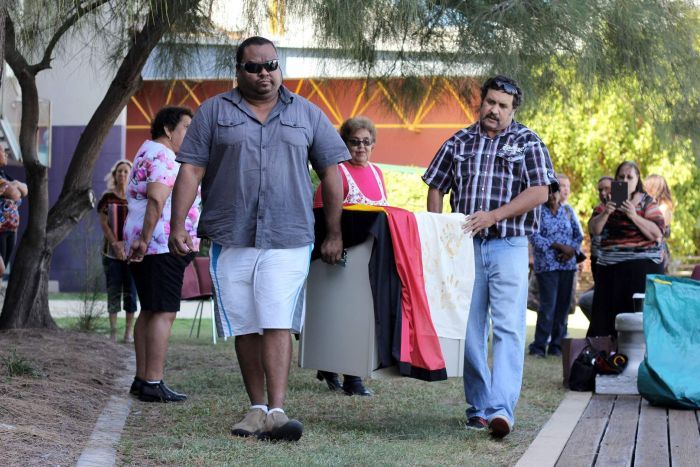
Great, great, great grandsons carry the remains of King Ng:tja following the smoking ceremony. After the smoking ceremony, his repatriation to country passes to the men in the family.
Recently, Ngadjon-Jii representatives, Aunty Vera Ketchell and Richard Hoolihan, received their ancestor King Ng:tja, Barry Clarke, from the Berlin Society of Anthropology, Ethnology and Prehistory. King Ng:tja’s remains were returned at a smoking ceremony at the Australian Embassy in Berlin.As Aunty Vera commented during the ceremony,
“This is only the start of the journey. The important ceremony for the Ngadjon-Jii community and family begins when we return granddad Barry to the rainforest and guide his spirit back to Country.”
Aunty Vera and Mr Hoolihan accompanied granddad Barry home to Australia in late March 2017.Today, the Ngadjon-Jii members conducted a traditional smoking ceremony at the Museum of Tropical Queensland to prepare granddad Barry for his temporary resting. The community will arrange for his final resting on Country in the coming months.
“This will be the time for the community to come together to complete the grieving process and have closure,” said Aunty Vera.
The Indigenous Repatriation Program administered by the Department of Communications and the Arts facilitated the return of King Ng:tja’s remains and the participation of his descendants in the smoking ceremony. The Indigenous Repatriation Program seeks to facilitate the voluntary and unconditional return of Australian Indigenous ancestral remains from overseas collecting institutions and private holders. Program staff work closely with community members throughout the repatriation process.Once ancestors are returned to Australia, community members may work with state and territory museums to provide temporary care for their ancestors while arrangements are prepared for return to Country. Community members may also request the assistance of their state or local governments to assist with reburial.
Returning the mummified remains of Aboriginal man King Ng:tja to his family in Queensland has marked the next step in returning the deceased elder to country. King Ng:tja (also known as Barry Clarke) was an elder of the Ngadjon-Jii people of Malanda in far north Queensland. His mummified remains were removed from Australia in 1905 by German anthropologist Hermann Klaatsch, and have been in the possession of the Berlin Society for Anthropology, Ethnology and Prehistory for decades.
His body was returned to Australia in March 2017, then transferred to the Museum of Tropical Queensland in Townsville.On Friday about 20 members of King Ng:tja's family held a smoking ceremony and viewed his body at the museum as part of his repatriation process.
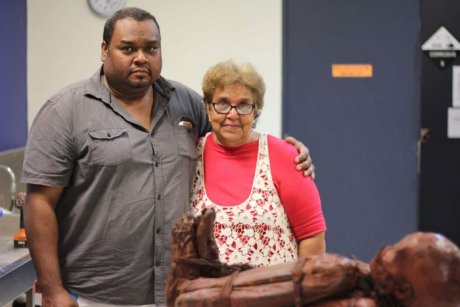
Descendants Robin and Vera Ketchell with King Ng:tja's remains.
Relief to have ancestor back home Great, great, great grandson Robin Ketchell said it was very moving to have "Grandad Barry" back in Australia.
"Hearing stories of him from when I was a boy, family talking about Grandad Barry, things he did, to finally see him with my own eyes is truly emotional," Mr Ketchell said
"Not sad, more of a happy grateful to see him back on country."
Great, great granddaughter Vera Ketchell said the family learned of their ancestor's whereabouts in the 1980s, but it was not until 2015 that they could start to negotiate his return.
"Today is a relief to know that we have now got him home in Australia," Ms Ketchell said. "We have done the first leg of the journey of bringing him back and seeing him being out of his box, and we now know we can work forward to finding him a resting place and taking him home to country.
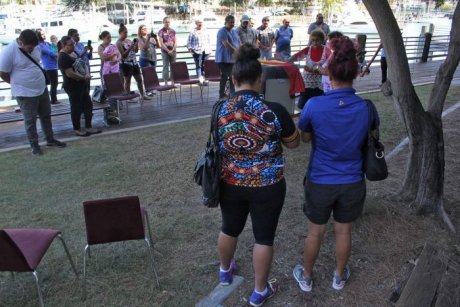
Vera Ketchell and Maxine Illin smoke the box holding King Ng:tja's remains with burning leaves from the soapwood tree
Landmark repatriation expected to inspire others King Ng:tja's body is the first full mummified body to be repatriated to Australia and the first to be handed back to direct descendants. Museum of Tropical Queensland senior curator in anthropology, Kirsty Gillespie, said the museum was assisting the family by safely storing the body until plans were made for a final resting place. "It is quite overwhelming for communities to think about the very beginning and end all at once," Dr Gillespie said"Repatriation can take several years as we have seen in this particular case, so it really helps to have a museum much closer to where the ancestor can rest."
To date, 1,474 Aboriginal ancestral remains have been returned to Australia from overseas.It is estimated that more than 1,000 are still housed in overseas collections.Dr Gillespie said funding was available to assist with the repatriation of Aboriginal remains, but sometimes it was hard for family members to know where to start. "Others might have heard that they have an ancestor somewhere overseas, but they may not have documentation," Dr Gillespie said. "So researchers are able to support the community in that way, and cultural institutions like the Queensland Museum can also be a contact point."
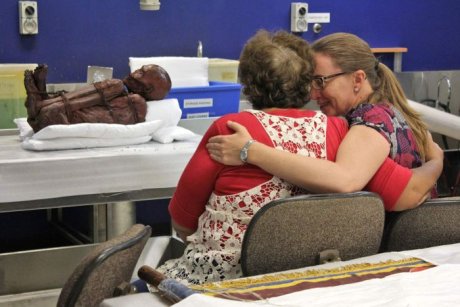
Vera Ketchell is comforted by anthropologist Kirsty Gillespie at the viewing.
King Ng:tja's body taken from grieving wife The collection of the bodies of Indigenous Australians was a common practice among anthropologists in the 19th century.
King Ng:tja's body was mummified according to Ngadjon-Jii tradition and was taken from his wife eight months into her mourning period.
Ms Ketchell said the theft of his body during "women's business" meant the ancestor's spirit had been unable to rest.
"He was still in transit at the time and his wife was carrying him around and going through her grieving process," Ms Ketchell said.
"But until he is back in his own country, his spirit is not settled yet."
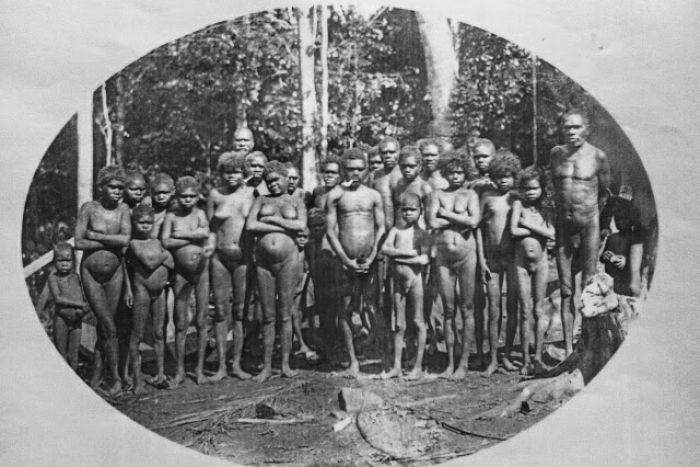
Ngadjon-Jii people of the Atherton Tablelands. The tall man on the right is thought to be King Ng:tja.
The family is currently exploring their options for King Ng:tja's final resting place.Ms Ketchell said there were some impediments to a traditional interment, so he may end up at Malanda cemetery.
"We can't take him back to his natural land. It is too hard to get to," she said. "We can't just leave him out on country because of the wildlife and other things, and we can't take him to a bora ground.
"There is a lot of desecration around some of the bora grounds up around the Tablelands and different areas. "If we get him into a secure tomb and face him towards [Mount Bartle Frere], his spirit can return."
Editor's note: Images shown above in this story have been used with the permission and encouragement of family members
Australian War Memorial resistance to Indigenous commemoration
In recent years, the Australian War Memorial has come under increasing pressure to reflect in its galleries the bloody conflict across the Australian pastoral frontier between soldiers, pastoralists, miners, militias and Indigenous warriors protecting their land after white invasion and settlement. But the memorial, under its director, Brendan Nelson, remains as intransigent on the matter as it does about the erection of an onsite monument specifically to honour Indigenous Australians who fought in the imperial forces. Instead Nelson has commissioned work on a monument depicting Aboriginal and Torres Strait Islander personnel serving alongside non-Indigenous colleagues. Meanwhile Nelson’s Indigenous liaison officer, Gary Oakley, is pushing for a separate monument, dedicated specifically to Indigenous Australian personnel, to be erected close to, but definitely not on, memorial grounds. The two positions may not be anomalous, but they certainly offer a confusing testimony to the fraught politics of commemoration, not least in relation to black servicemen and frontier war warriors. So, from a long-held memorial position that there should be no official Indigenous monument, there might soon be two. Both would be imperfect: Nelson’s because it would not be dedicated solely to Indigenous personnel, the other because it would be sited outside the memorial when it might just as easily be within.A solution would be to commission Hego to adorn a wall at the memorial with a replica mural. It could be done for a few thousand dollars – small change, really, given the $300m-plus Australia is spending on commemorating “Anzac 100” and the $32m spent on the memorial’s new galleries. Amid this profligacy, in an era of purported “budget emergency”, it is clear the memorial’s intransigence on Indigenous matters has always been about ideology, not money. “The Australian War Memorial is a place where we treat all service people equally and that is reflected in the way the memorial commemorates the commitment and sacrifice of all servicemen and women,” a spokesman, quoting Nelson, told me last year. But Aboriginal and Torres Strait Islanders were no more genuinely equal when they wore a uniform during the two world wars than they were before or after. And pitifully little is different today. With the probable single exception of Douglas Grant, they were not considered Australian citizens even while they wore the uniform. They fought for an empire that had taken their land, established a federation that still institutionally discriminates against them, killed their not-too-distant ancestors, under a union flag that symbolised bloody injustice to them. Their experience was definitely unique. The war memorial awkwardly points to the story it tells about Indigenous servicemen when asked about its intransigence on frontier war – even though it will not erect a simple statue to honour the unique experience of Aboriginal and Torres Strait Islander personnel.
In 2014, when I asked if Nelson was prepared to soften his opposition to depicting frontier violence, a spokeswoman said the memorial held “a rich collection of material related to Indigenous servicemen and women from the first world war: This includes embarkation information, prisoner of war records, Red Cross files, personal letters, service details, works of art, photographs and medals. We also have a significant project under way – ‘The Guide to Indigenous Service Collections at the Memorial’ will identify Aboriginal and Torres Strait Islanders who served during the first world war and display records and collection material related to their individual service.” This was nothing but a fig leaf, for I hadn’t asked about Indigenous servicemen at all. Oakley, a former submariner in the Royal Australian Navy, has recounted how a previous war memorial director, Steve Gower, an ex-general, had said to him that he’d “had no problem with Indigenous soldiers. We’re all the same.” Oakley explained: “And I’d go, ‘Yes, we are but we’re not. We join the defence force for different reasons. We are a nation of people who’ve been around for a long time. We are not the same as everybody else. To us everybody else is a foreigner. We are the traditional owners of the land … My service to the nation in the defence force, I see that differently. In my eyes I’m doing this for country. It’s different. It’s a different way of thinking.”
Yes, it is different, indeed, as illustrated by the lives of many black diggers who served, especially in the first world war. Especially Douglas Grant. Harry Gordon interviewed Roy Kinghorn, a war contemporary of Grant’s, for his book The Embarrassing Australian. Kinghorn said he would see Grant every Anzac Day: He used to speak Gaelic fluently, and I was always asking him to stop using the wretched language. He used to enjoy himself at the reunions early after the war, but he became a sadder, progressively more dejected figure as each April the 25th went by. One day in the late 40s, I saw him sitting under a tree as the fellows from my old unit were marching into the Domain … I broke out of the ranks and went across to him. ‘What are you doing there?’ I asked. ‘Why aren’t you with your old mates? ‘I’m not wanted any more,’ Grant told me. ‘I don’t want to join in. I don’t belong. I’ve lived long enough.’” It was about then that Douglas Grant – Poppin Jerri – moved to a modest veterans’ hostel at La Perouse, an Aboriginal settlement on the northern headland of Botany Bay, whose original inhabitants, the Kameygal, can claim continuous precolonial settlement dating back tens of thousands of years.
Born black, raised white, Douglas Grant died an Indigenous man at La Perouse in 1951.
This version of this article first appeared in the March edition of Meanjin, volume 71, number 1, 2015

